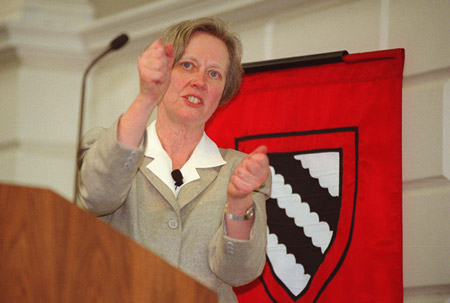‘Genetic arms race’ described
Princeton¹s President Tilghman talks at Radcliffe

There’s no cease-fire in the battle of the sexes, at least not at the genetic level, said pioneering genetics researcher and Princeton University President Shirley M. Tilghman in her Dean’s Lecture Series talk at the Radcliffe Institute for Advanced Study Monday afternoon (March 18).
In her lecture, titled “Genomic Imprinting: A Genetic Arms Race,” Tilghman described “an arms race where the weapons in the race are genes, where the protagonists are parents, and where the battlefield is the placenta and the uterus.”
Tilghman, a world-renowned scholar and leading expert on genomic imprinting, has served on the Princeton faculty as the Howard A. Prior Professor of the Life Sciences since 1986. In her introduction, Radcliffe Dean Drew Gilpin Faust noted that Tilghman had been invited to speak in the Dean’s Lecture Series before she was named Princeton’s 19th president in May 2001. “We didn’t know this would be a state visit,” said Faust.
As a member of the ad hoc committee that shaped the transition of Radcliffe from a college to an institute of advanced study, Tilghman helped shape the institute that hosted her talk. “She played a critical role in the creation of what Radcliffe has become,” said Faust.
Tilghman told the audience, which included President Lawrence H. Summers and Provost Steven Hyman, that she welcomed the opportunity to speak about her science, a topic less often requested of her since she assumed presidential duties at Princeton.
Tilghman is the founding director of the Lewis-Sigler Institute for Integrative Genomics at Princeton and a founding member of the National Advisory Council of the Human Genome Project Initiative for the National Institutes of Health.
Often described as an exceptional teacher, Tilghman proved the truth of the characterization, skillfully distilling complex genetic research into a lively, general-interest discussion, and warning the audience that packed Askwith Lecture Hall that “after this lecture, it is very likely that you will look at your parents differently than you have ever thought about them in the past.”
Genomic imprinting, Tilghman explained, seems to regulate fetal growth in mammals. In the mid-1980s, Gregor Mendel’s 150-year-old assumption that an offspring inherits equivalent genetic material from its father and mother was disproved in mammals. By the early 1990s, it was confirmed that genomic imprinting marks some genes to be “silent”; either the mother or father could affect the ability of the gene to be expressed in the offspring.
Tilghman called genomic imprinting “one of the great mysteries of genetics,” flying in the face of evolution. By eliminating one copy of genes, imprinting puts the offspring at greater genetic risk.
Tilghman’s “battle of the sexes” is waged within the mammalian embryo, as the father’s genes try to promote fetal growth while the mother’s genes seek to slow growth. Tilghman drew on research by David Haig, associate professor of biology in Harvard’s Department of Organismic and Evolutionary Biology, for an explanation for imprinting.
In polygamous mammals, where the males mate with many females, paternal genomes are essentially selfish: They will promote the growth of its offspring, encouraging it to grow as big as it can without concern for the health of the mother or her future offspring, Tilghman said.
Maternal genomes, on the other hand, counteract that by slowing growth to ensure the survival of not just this but future fetuses. Thus, said Tilghman, this “arms race” between the mother’s and father’s genes balances out to create an offspring size that is optimal for the species, neither giants nor dwarfs, which would not survive.
Tilghman demonstrated the effect of imprinting in several crossbreeds of mammals and discussed its impact on cloning. Dolly the cloned sheep was a rare success, she said, because unstable imprints are a significant barrier to efficient animal cloning.
“Imprinting is helping us create diversity,” said Tilghman. “It may be contributing to the creation of new species.”




